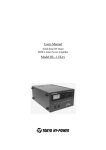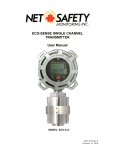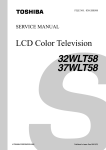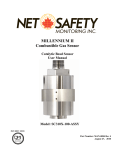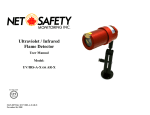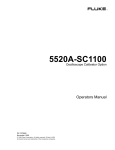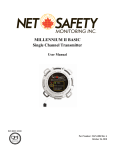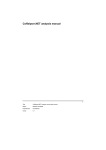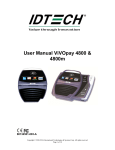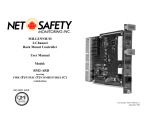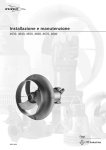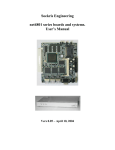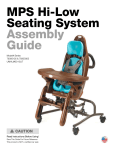Download MILLENNIUM Combustible Gas Detector
Transcript
MILLENNIUM Combustible Gas Detector User Manual Models: MLP- A/AR/AD- SC1100 MLP- LP-A/AR/ARS - SC1100 Part Number: MAN-0047 Rev 12 July 24, 2009 Warranty IMPORTANT INFORMATION This manual is for informational purposes only. Although every effort has been made to ensure the correctness of the information, technical inaccuracies may occur and periodic changes may be made without notice. Net Safety Monitoring Inc., assumes no responsibility for any errors contained within this manual. If the products or procedures are used for purposes other than as described in the manual, without receiving prior confirmation of validity or suitability, Net Safety Monitoring Inc., does not guarantee the results and assumes no obligation or liability. No part of this manual may be copied, disseminated or distributed without the express written consent of Net Safety Monitoring Inc. Net Safety Monitoring Inc., products are carefully designed and manufactured from high quality components and can be expected to provide many years of trouble free service. Each product is thoroughly tested, inspected and calibrated prior to shipment. Failures can occur which are beyond the control of the manufacturer. Failures can be minimized by adhering to the operating and maintenance instructions herein. Where the absolute greatest of reliability is required, redundancy should be designed into the system. Net Safety Monitoring Inc., warrants its sensors against defective parts and workmanship for a period of 24 months from date of purchase; other electronic assemblies for 36 months from date of purchase. No other warranties or liability, expressed or implied, will be honoured by Net Safety Monitoring Inc. Contact Net Safety Monitoring Inc., or an authorized representative for details. We welcome your input at Net Safety Monitoring. If you have any comments please contact us by phone, at the address below or visit our web site and complete our on-line customer survey: www.netsafety.com. Contact Information Net Safety Monitoring Inc. 2721 Hopewell Place NE Calgary, AB Canada T1Y 7J7 Telephone: (403) 219-0688 Fax: (403) 219-0694 www.net-safety.com E-mail: [email protected] Part Number: MAN-0047 Rev 12 July 24, 2009 Net Safety Monitoring Inc. Modbus Termination ................................................................... 13 Table of Contents SECTION 4: OPERATE .................................................................. 14 Introduction ....................................................................................... 5 Calibration Button .................................................................... 16 The Product ........................................................................................ 5 Magnetic Reed Switch .............................................................. 16 The Sensor .................................................................................. 5 Power Up .................................................................................. 16 The Controller (Transmitter) ...................................................... 5 Current Loop Measurement (Test Jacks) ................................. 16 The Manual ................................................................................ 5 Status LED ................................................................................ 16 SECTION 1: PLAN .......................................................................... 6 The Main Menu ............................................................................ 17 1.1 LOCATE CONTROLLER / SENSOR .................................... 6 Main Menu Functionality ......................................................... 17 SECTION 2: Install ............................................................................ 8 SECTION 5: Calibrate ..................................................................... 17 Unpack ........................................................................................... 8 Calibration Procedure .................................................................. 17 SECTION 3: Wire ............................................................................. 9 Steps in Calibration Procedure ..................................................... 18 Field Installation ............................................................................ 9 Remote Calibration ...................................................................... 18 Seal ................................................................................................. 9 Abort Calibration ...................................................................... 19 Connecting Wires ..................................................................... 10 Sensor Life Check ..................................................................... 19 Board Assembly ....................................................................... 10 Sensor Near End of Life ............................................................ 19 Sensor and Controller .................................................................. 11 End of Sensor Life, Replace Sensor .......................................... 19 Relay Board .............................................................................. 12 Calibration Failure .................................................................... 19 RS‐485 Communication ............................................................ 12 SECTION 6: Monitor ....................................................................... 19 Sensor Separation ........................................................................ 12 Review Relay Settings ................................................................. 19 CURRENT OUTPUT ....................................................................... 12 Set Relay Option .......................................................................... 19 NON‐ISOLATED AND ISOLATED POWER CONFIGURATIONS ........ 13 Steps in setting relay options ....................................................... 20 Remote Reset ............................................................................... 13 Enter Restricted Menu ................................................................. 20 3 MAN-0047 Rev 12 MLP-A/AR/AD-SC1100 & MLP- LP-A/AR/ARS-SC1100 Net Safety Monitoring Inc. Extend Sensor Separation ............................................................ 21 Table 6: Troubleshooting guide ............................................... 25 Set Low Power Options - Optional .............................................. 21 How to Return Equipment ............................................................... 26 Select Display Language .............................................................. 21 Spare Parts/Accessories ............................................................... 26 Modbus Options ........................................................................... 21 FACE ROTATION OPTION ...................................................... 27 Node Address ........................................................................... 21 Rotate PCB Assembly ............................................................... 27 Baud Rate ................................................................................. 22 Alarms .......................................................................................... 22 AppendixA : ................................................................................ 29 Electrostatic Sensitive Device (ESD) ................................................. 29 Sensor Fault.............................................................................. 22 AppendixB Sensor Drift .............................................................................. 22 Appendix B: Resistance Table (cont’d) ............................................. 31 Gas Present................................................................................... 22 AppendixC : Resistance Table ..................................................... 30 : Sensor Specifications .............................................. 32 Sensor Life ................................................................................ 22 Controller Specifications .................................................................. 33 Sensor Guard ............................................................................ 23 Reset ............................................................................................. 23 Manual Reset ........................................................................... 23 Remote Reset ........................................................................... 23 Outputs ......................................................................................... 23 Relays (Optional) ...................................................................... 23 Modbus .................................................................................... 24 Current ..................................................................................... 24 SECTION 7: Maintain ..................................................................... 24 Periodic Response Check ............................................................. 24 Troubleshoot ................................................................................ 24 4 MAN-0047 Rev 12 MLP-A/AR/AD-SC1100 & MLP- LP-A/AR/ARS-SC1100 Net Safety Monitoring Inc. Introduction The Millennium series is a part of Net Safety's innovation in a line of continuously evolving industrial gas detectors and sensors. The microcontroller based system provides fast, accurate and continuous monitoring of gases in extreme environments. SECTION 1 PLAN SECTION 2 INSTALL SECTION 3 WIRE SECTION 4 OPERATE SECTION 5 CALIBRATE SECTION 6 MONITOR SECTION 7 MAINTAIN The Product The Sensor The SC1100 combustible gas sensor is a proven, poison resistant, pellistor sensor utilizing active and reference catalytic beads in a Wheatstone Bridge configuration. Its integrated design ensures accurate and repeatable response in the most severe environments. The Controller (Transmitter) The Millennium Controller has an Explosion-Proof Housing, rated Class 1, Division 1, Groups B, C, and D for hazardous applications. It was designed for either a 1-man, intrusive calibration or 2-man non-intrusive calibration. The Controller has convenient user interface functionality to make installation, operation and maintenance easy. The Manual The manual has been designed to make installation of the Millennium product easy. To ensure proper installation, follow the steps outlined in the following pages. If you encounter problems during operation, consult the troubleshooting section or contact your sales representative. 5 MAN-0047 Rev 12 MLP-A/AR/AD-SC1100 & MLP- LP-A/AR/ARS-SC1100 Net Safety Monitoring Inc. SECTION 1: PLAN 1.1 LOCATE CONTROLLER / SENSOR Prior to the installation process, a location plan for placing the controller and sensor should be developed. Although there are no absolute rules determining the quantity and location of a sensor or controller, the following points should be considered when planning the installation. • Locate the controller where it will be accessible and visible. • Carefully locate sensor in an area where gases may potentially accumulate. • Use redundant systems to enhance protection and reliability. • Light gases tend to rise; heavy gases tend to accumulate in low areas. • Consider the air movement patterns within the facility. • Consider the construction of the facility (such as trenches where heavy gases may accumulate or peaks where light gases may accumulate) • Seek advice from experts knowledgeable about the primary gas to be detected. • Use common sense and refer to the regulatory publications that discuss guidelines for your industry. The two most common installations options are as follows. Option 2 The sensor is attached directly to the controller. See “Wiring – Controller and Sensor” for details. The CCS-1 and tubing is used to facilitate calibration. TIP: The Calibration Cup (CCS-1) allows for tubing to be affixed to a sensor mounted in remote locations. The tubing s directed to a level, usually close to the controller, for easy injection of calibration gas. The calibration cup can also act as a splash guard, protecting sensors mounted low to the ground. Figure 1: Locate Sensor/Controller - Separated Option 1 Locate the sensor separate from the controller using a Certified Junction Box. If the Net Safety Multi-purpose Junction Box is being used, refer to MAN-0081 for terminal designations. The controller is located near eye- level. Conduit is run from the controller to the sensor. A Calibration Cup (CCS-1) can be attached to the sensor. Tubing can be run from the CCS-1 to a convenient location accessible for calibration gas to be injected. CCS‐1 6 MAN-0047 Rev 12 MLP-A/AR/AD-SC1100 & MLP- LP-A/AR/ARS-SC1100 Net Safety Monitoring Inc. Figure 2 below shows the Controller with sensor and the Multipurpose Junction box with sensor attached. Figure 2: Dimensional Drawing Controller with sensor Multi-purpose Junction box with sensor 7 MAN-0047 Rev 12 MLP-A/AR/AD-SC1100 & MLP- LP-A/AR/ARS-SC1100 Net Safety Monitoring Inc. SECTION 2: Install Unpack Carefully remove all components from the packaging. Check components against the enclosed packing list and inspect all components for obvious damage such as broken or loose parts. If you find any components missing or damaged, notify the representative or Net Safety Monitoring immediately. Figure 3: Components Controller Base Housing Millennium Faceplate SC1100 Sensor External Equipment Controller Housing cover Ribbon connecting faceplate/controller It is necessary that reliable monitoring and indicating devices or systems be connected to the detector. These devices must be designed to produce clear visual and audible danger signals when high signal levels occur. 8 MAN-0047 Rev 12 MLP-A/AR/AD-SC1100 & MLP- LP-A/AR/ARS-SC1100 Net Safety Monitoring Inc. • Mount The controller should be mounted near eye-level and be easily accessible for calibration and maintenance purposes. The sensor should be placed where gas is likely to accumulate. • Ensure all devices are securely mounted, taking into consideration all requirements. If necessary use the Face Rotation Option to mount the Millennium Controller at a different orientation. Refer to “Face Rotation Option” for detailed instructions. SECTION 3: Wire • Seal The use of seals is recommended to further protect the system against any unwanted water ingression, and equipment should be installed according to applicable local electrical codes. Seals are especially recommended for installations that use high-pressure or steam cleaning devices in proximity to the transmitter and/or sensor. • Field Installation Wiring codes and regulations may vary. Wiring must comply with applicable regulations relating to the installation of electrical equipment in a hazardous area and is the responsibility of the installer. If in doubt, consult a qualified official before wiring the system. See some wiring considerations below. Warning • • • The maximum distance between sensor and controller is limited by the resistance of the connecting wiring, which is a function of the gauge wire being used. See Appendix B. When developing a RS-485 chain of devices, the last device in the chain requires end of line termination. RS-485 connection 2-wire, multipoint serial line. If the 4-20 mA signal is not used, connect a jumper between the 4-20 mA terminal and the Common terminal. The use of shielded cable is highly recommended for signal, input, output and power wires to protect against interference caused by extraneous electrical or electromagnetic 'noise'. In applications where the wiring cable is installed in conduit, the conduit must not be used for wiring to other electrical equipment. • • • • • Water-proof and explosion-proof conduit seals are recommended to prevent water accumulation within the enclosure. Seals should be located as close to the device as possible and not more than 18 inches (46 cm) away. Explosion-proof installations may require an additional seal where conduit enters a non-hazardous area. Ensure conformity with local wiring codes. When pouring a seal, use a fibre dam to ensure proper formation of the seal. Seals should never be poured at temperatures below freezing. The jacket and shielding of the cable should be stripped back to permit the seal to form around the individual wires. This will prevent air, gas and water leakage through the inside of the shield and into the enclosure. It is recommended that explosion-proof drains and conduit breathers be used. In some applications, alternate changes in temperature and barometric pressure can cause 'breathing' which allows moist air to enter and circulate inside the 9 MAN-0047 Rev 12 MLP-A/AR/AD-SC1100 & MLP- LP-A/AR/ARS-SC1100 Net Safety Monitoring Inc. conduit. Joints in the conduit system are seldom tight enough to prevent this 'breathing'. Note: Boards are susceptible to ESD. Refer to Appendix A Electrostatic Sensitive Device (ESD)" Figure 5: Millennium Module Boards Connecting Wires 1. Use a small screw driver to gently press down and hold the spring connector open. 2. Insert appropriate wire into open connector hole. 3. Release screw driver to secure wire. Figure 4: Securing wires Solid State Relay Board Fault + Low + High + - Option Board Terminal Board High Low Fault Electromechanical Relay Board FNO Normally open FCOM Common FNC Normally closed LNO Normally open LCOM Common LNC Normally closed HNO Normally open HCOM Common HNC Normally closed Board Assembly There are three different user-allowed removable boards; relay board (Solid State or Electromechanical), Option board and Modbus board. These Boards are field replaceable. Simply loosen the locking standoffs, remove one board, insert the other board and tighten screws. Depending upon requirements, either an Electromechanical or Solid State Relay Board module can be used. Sensor Board Modbus Terminals A B COM - 10 MAN-0047 Rev 12 MLP-A/AR/AD-SC1100 & MLP- LP-A/AR/ARS-SC1100 Net Safety Monitoring Inc. Sensor and Controller Table 2: Controller Terminal connection Power Terminals Controller Power Connections (Terminal Board) RST ↔ Remote Reset +24VDC ↔ Power(+) COM ↔ Power(-) 4-20 ↔ Current loop output ISO ↔ +24V isolated 4-20 Power to the unit must be OFF before wiring. Also ensure area is de-classified before removing housing cover. Warning Note: The Sensor may be factory installed to the Controller. If so, you need only connect the Power Terminals. 1. Remove the Controller’s Housing Cover. 2. Connect the sensor to the Sensor Terminals (if necessary) and the Power Terminals to power and output signal wires. 3. Turn controller on (put ON/OFF Switch in ‘ON’ position). 4. Replace Controller’s Housing cover. Apply power to unit. 5. Ensure display reads Start Delay, Status LED is Red Slow Flash and current output displays 3.0 mA. This is the start-up delay sequence which will last approximately 90 seconds. Figure 6: Wiring - Controller and Sensor RST +24VDC Refer to Tables 1and 2 along with Figure 6, for wiring. Terminal Board Table 1: Sensor Terminal connection Sensor Wire White Red Black Sensor Terminals Terminal designation ↔ Wht(+) ↔ Red Blank space ↔ Blk(-) Shld Com Power Terminal 4-20 A B Modbus RTU Terminal to PLC IS0 Com - Note the terminal designations on sensor terminal board i.e. Wht (+), Red, Blank space (no connection), Blk (-) and Shld. Sensor Board Sensor Wires Wht Red Sensor Terminal Blk SC1100 Sensor 11 MAN-0047 Rev 12 MLP-A/AR/AD-SC1100 & MLP- LP-A/AR/ARS-SC1100 Net Safety Monitoring Inc. Note: If the 4-20 mA signal is not used, connect a jumper between the 4-20 terminal and the COM terminal on the Terminal Board. Relay Board Refer to Figure 5, “Millennium Module Boards" for relay board location and termination. RS-485 Communication Connect devices in a chain via the Modbus terminals. The last device in the chain requires end of line termination. Refer to “Modbus Termination”. CURRENT OUTPUT To set the current output, simply move the jumper located on the Terminal Board near the power terminals, to the isolated or non isolated current position. Refer to Figure 7. Note: Unless otherwise specified, all models ship with this jumper in the non-isolated current position (Pin 2 and Pin 3 jumpered). Refer to Figure 7. Figure 7: Jumper Position Power Terminals Sensor Separation Since the sensor must be located where gas is likely to accumulate and the controller where it can be easily reached, it is often necessary to “separate” the controller and sensor. This is done with the aid of the Sensor Separation kit. The Sensor Separation kit is composed of a Net Safety Multi-purpose Junction Box and terminal strip. For terminal definitions refer to the Multi-purpose Junction Box manual (MAN-0081). Terminal Board Shielded copper instrument wire (minimum 18 AWG) should be used for separations up to 75 feet. Shielded copper instrument wire (minimum 16 AWG) should be used for separations up to 150 feet. Note: Factory default for Sensor Separation is 0-75 feet. The actual physical distance between the sensor and controller must be defined. See "Extend Sensor Separation for instructions on setting the sensor separation distance. Note: If the 4-20 mA signal is not being used, connect a jumper between the 4-20 mA terminal and the COM terminal on the Terminal Board. Sensor Board Jumper positions to set power source for current output. Isolated & Non-Isolated Current Jumper - Place Jumper (shorting jack) over Pin 3 and Pin 2 (default position) for Non-Isolated configuration (source). Place Jumper over Pin 1 and Pin 2 for remaining configurations. See Figure 8. Termination Jumper – Non- functional in this application and can be placed in any position or removed. Sensor Terminals 12 MAN-0047 Rev 12 MLP-A/AR/AD-SC1100 & MLP- LP-A/AR/ARS-SC1100 Net Safety Monitoring Inc. NON-ISOLATED AND ISOLATED POWER CONFIGURATIONS For current source using Non-Isolated configuration, the jumper must remain in the default position (Pin 2 and Pin 3 jumpered). The jumper is placed over Pin1 and Pin 2 for current sink using NonIsolated configuration. For Isolated configuration using a separate power supply to isolate the current loop, the jumper must be placed over Pin 1 and Pin 2 for source and sink. See Figure 7 and Figure 8. Note the Jumper position for each configuration. Figure 8: Current Source and Sink Drawing Remote Reset If the Millennium relays are set for latching a remote reset can be done to reset the relays. This is done with a normally open Push Button Switch connected between the RST and COM terminals on the Terminal Board. See Figure 9. Figure 9: Remote Reset Terminal Board Power Terminal Strip Modbus Termination Devices can be networked in a daisy chain. The device located at the end of the chain requires end of line termination. Place both jumpers over the pins as shown in the Figure 10 below. Figure 10: Modbus Termination Jumpers JP1 Modbus Board JP2 13 MAN-0047 Rev 12 MLP-A/AR/AD-SC1100 & MLP- LP-A/AR/ARS-SC1100 Net Safety Monitoring Inc. SECTION 4: OPERATE Figure 11: Controller Functionality Reed Switch –provides nonMagnetic intrusive access for programming, zeroing and resetting. -Place magnet against housing as indicated for less than one second to initiate a basic system reset (clear latched alarm) and make selections. –Place magnet against housing as and hold to access, select, indicated view settings and zero. Scrolling 8 character display- provides various status messages and prompts. Refer to “Status LED’s, Display Messages and Current Loop” Pull Here knob-unscrew the two screws and pull to remove faceplate. Removal allows access to terminal boards. The face plate remains attached to the ribbon cable Status Light (flashes Red or Green) to indicate status of unit. Refer to “Status LEDs, Display Messages”, for detailed explanation. ON/OFF Switch –used to turn controller on and off. Housing must be removed to access. Pull Here knob Setup Button –provides intrusive access for programming, zeroing and resetting. -Push for less than one second to initiate a basic system reset (clear a latched alarm) and make selection. -Push and hold to program, view current settings and zero. Current Output Check –test jacks to facilitate current loop measurements without breaking external current loop. To take current loop measurements ensure wiring is correct and current loop is closed, and then follow steps below -Set meter on mA scale and insert meter leads into test jacks. -Set external devices to bypass, if necessary, to avoid unwanted alarm response -Perform simulated tests to check output -Remove meter leads from test jacks and return external devices to normal 14 MAN-0047 Rev 12 MLP-A/AR/AD-SC1100 & MLP- LP-A/AR/ARS-SC1100 Net Safety Monitoring Inc. Table 4: RTU Status register(40002) Read only (binary) Table 3: Status LEDs, Display messages and current loop State Current output Status LED Red or Green Display Calibrate sensor 3.0 mA N/A N/A Normal operation Start-up delay (90 seconds) Access main menu & options Green blip/blink 4.0 mA 3.0 mA Red Slow flash 3.0 mA Memory error 2.5 mA Sensor lead open 2.5 mA Excess drift (>10%) 2.5 mA Auto Zero set 3.0 mA Switch on (10→0) Memory error Sensor Fault Red slow flash Red slow flash Red blip/blink 0x0001 Fault(sensor) RTUstat_low_alarm 0X0002 Low alarm tripped RTUstat_high_alarm 0X0004 High alarm tripped RTUstat_low_alarm_latched 0X0008 Low alarm latched RTUstat_high_alarm_latched 0X0010 High alarm latched RTUstat_lel_60_latched 0X0020 60% LEL latched RTUstat_lel_100_latched 0x0040 100% LEL latched RTUstat_powerUp 0x0080 Power up delay RTUstat_cal_cycle 0X0100 Calibration cycle in progress RTUstat_zeroing 0x0200 zeroing RTUstat_apply_span_gas 0x0400 Apply span gas RTUstat_calibrating 0x0800 Calibrating RTUstat_remove_gas 0x1000 Remove gas RTUstat_cal_complete 0x2000 Calibration complete RTUstat_mem_error 0X4000 Memory error Neg. drift Green Solid Apply cal. gas 3.3 mA Span is set, remove gas 3.6 mA Green solid Apply clean air Apply 50% span gas Remove gas Calibration successful 3.6 mA Green solid Cal. complete Sensor guard 20.0 mA Gas present >4-20 mA Failed calibration 3.0/3.3 mA Red fast flash Red Solid Red blip/blink Red flash RTUstat_fault 00 %LEL Start delay N/A RTU Status Registers and meaning 100%LEL 1-100% full scale Green flash Fail cal. Note: Register 40001 = LEL output (read only) Register 40002 = RTU status (read only) Register 40101 = Reset latched relays (write) 15 MAN-0047 Rev 12 MLP-A/AR/AD-SC1100 & MLP- LP-A/AR/ARS-SC1100 Net Safety Monitoring Inc. Calibration Button The Calibration Button provides access to the Millennium’s Main Menu, which in turn allows calibration and options to be reviewed and set. Refer to Figure 11, “Controller Functionality" , for more information. • • Press and hold the Calibration Button to calibrate and access Main Menu. Briefly press to make a selection (select YES?). Do not open the controller in a classified area (Do not open when an explosive atmosphere may be present). Do not power up the system with the housing cover removed unless the area has been de-classified. Warning Magnetic Reed Switch The Magnetic Reed Switch is provided to avoid opening the housing in an environment where gas may be present. The Magnetic Reed Switch functions in the same manner as the Calibration Button but in a non-intrusive manner. Refer to Figure 11, “Controller Functionality", for more information. When power is applied, the system is automatically tested to ensure proper functionality. After warm-up, the controller will enter normal operation, the display reads 00 %LEL, Status LED will blip/blink Green and analog output will change to 4.0 mA. Current Loop Measurement (Test Jacks) Use a standard meter to measure current loop during various states. The Controller’s Housing cover must be removed to access the Test Jacks. Refer to Table 3: "Status LEDs, Display Messages and Current Loop,” for a detailed list and Figure 11, “Controller Functionality", for more information. Status LED The Status LED will remain solid, flash, blip and/or blink, either Red or Green, to indicate various states. Refer to Table 3, “Status LEDs, Display Message”. When using the magnet: Place and hold the magnet to the Controller’s Housing (10 o’clock position) to calibrate and access Main Menu. Briefly place the magnet to the Controller’s Housing (10 o’clock position) to make a selection (select YES?). Power Up Turn the power switch on. A 90 second warm-up routine will begin. The display reads Start Delay Millennium Net Safety, the Status LED will flash slow red and current output displays 3.0 mA. 16 MAN-0047 Rev 12 MLP-A/AR/AD-SC1100 & MLP- LP-A/AR/ARS-SC1100 Net Safety Monitoring Inc. 4. To select an option, momentarily place the magnet to the Reed Switch or press the Calibration Button at the YES? prompt. 5. If you do not wish to select that option wait until the next option appears and then select YES?. 6. A selection is acknowledged with a flashing YES. 7. If no option is selected, the controller returns to 00 %LEL (normal operation). The Main Menu The Main Menu provides access to various functional settings and viewing of current settings. • • • • • • Calibrate Sensor. Review Relay Settings (optional) - Review the current Fault, Low and High alarm settings. This is a read only option. Set Relay Options (optional) - Set the Low and High alarm settings. Restricted Menu - Set the sensor separation distance and choose low power options. Select a display language - English, Spanish or French. Select Modbus Options (option only available if Modbus board is used i.e. digital model). Note: The current output will drop to 3.0 mA while accessing the Main menu. Accessing the Main Menu There are two ways to access the Main Menu: • • Calibration Button found on the faceplate (the housing cover must be removed to access) Magnetic Reed Switch (a magnet must be used to activate) Main Menu Functionality 1. Ensure that the controller has been turned on and no fault is present. 2. Hold the magnet against the Reed Switch or press and hold the Calibration Button until the message Switch On displays and the countdown (10 to 0) finishes. 3. An option will scroll across the display followed by the prompt YES? SECTION 5: Calibrate Calibration Procedure The calibration procedure requires about 5 minutes to complete. If gas is not applied at the appropriate time, a calibration failure may occur. Refer to "Calibration Failure” for specific information. Warning For accurate performance, the Millennium should be calibrated using 50% span of the specific gas of concern. The concentration of gas, corresponding to 100% of full scale, is converted to a linear 4 to 20 mA output signal which can be powered from the primary dc supply of the instrument. Power up the unit for at least 4 hours BEFORE the first calibration. The following calibration procedure should be followed to ensure an accurate correlation between the 4 to 20 mA output signal and the gas concentration. To compensate for distance when remotely calibrating (sensor wired for separation), decrease the tubing diameter or increase the calibration gas flow rate between canister and sensor. Always confirm calibration by applying gas directly at the sensor. Warning 17 MAN-0047 Rev 12 MLP-A/AR/AD-SC1100 & MLP- LP-A/AR/ARS-SC1100 Net Safety Monitoring Inc. Figure 12: Calibration Procedure Place system into Bypass if necessary Display: Calibrate sensor Yes? Action: Select Yes? Methane? Select Yes? for methane or ignore message if target LEL gas is not methane Apply clean Air Apply 50% Span Gas Apply clean Air Apply specific LEL gas Calibrating Remove Gas Cal. Complete Remove Gas Apply clean air to purge the system Stop Bypass if necessary Steps in Calibration Procedure Refer to "Remote Calibration”, if remote calibration is to be performed. 1. Confirm successful power up of controller—LED Green Blip/blink every 2 seconds; no fault indicated. 2. Flow certified Clean AIR at a rate of 0.5 litres per minute through the calibration cup for 1 minute to ensure clean air environment. 3. Press and hold the Calibration Button or use the Reed Switch to access the Main Menu and wait for countdown (10-0) to complete. 4. When Calibrate Sensor YES? displays, use the Calibration Button or Reed Switch to select YES? Selection will be confirmed by a flashing YES. 5. The prompt Methane YES? will display. If calibrating for methane use the Calibration Button or Reed Switch to select, otherwise (for another target LEL gas) ignore and wait for next prompt. Note: The purpose of the prompt “Methane YES ?” is for activating the sensor life feature for methane gas only. 6. When Apply Clean Air displays apply clean air. 7. Wait for Apply 50% Span Gas to display and apply specific LEL gas at a rate of 0.5 litres per minute (use 1.0 litre per minute for remote calibration). 8. The display will show Calibrating as gas is detected. 9. Remove span gas when the message Remove Gas displays (Status LED Green solid and 3.6 mA output). 10. The message Cal Complete will display when calibration is completed. 11. Apply clean air again to purge system. Note: Always apply test gas after calibration to verify operation. Remote Calibration The preferred tubing has an inside diameter of 3/16"; stainless steel tubing is excellent, plastic tubing is good. Within 10ft/35m, a flow rate of 0.5 litre per minute can be used but 1.0 litre per minute is recommended. Always use 1.0 litre per minute for distances (calibration tube lengths) between10ft to 100ft. Contact Net Safety if a remote calibration distance is greater than 100 ft/30 m is required. 18 MAN-0047 Rev 12 MLP-A/AR/AD-SC1100 & MLP- LP-A/AR/ARS-SC1100 Net Safety Monitoring Inc. Abort Calibration The Calibration procedure can be aborted. When the display shows Apply 50% Span Gas, press and hold the Reed Switch or Calibration Button until the countdown ‘10-0 Abort Calibration’ completes. After which the display shows Cal. Complete then returns to 00 %LEL. SECTION 6: Monitor Review Relay Settings This is a read-only mode; changes cannot be made. 1. Press and hold the Calibration Button or hold the magnet to the Reed Switch to enter the Main Menu; wait for the countdown, from 10 to 0, to end. 2. When Review Relay Settings displays press the Calibration Button or use the Reed Switch to select. The flashing YES confirms the selection. 3. The Fault Alarm is fixed (Energized / Non-Latching) and displays first, then the Low Alarm level, coil and latch status display, followed by the High Alarm level, coil and latch status. 4. At this point, the option to Set Relay Options YES? is displayed. Sensor Life Check Units, calibrated for methane only, indicate life expectancy of the sensor. Once calibration is complete, one of the following messages may display if the sensor needs replacing. Sensor Near End of Life - indicates the sensor will reach end of life before the next calibration can be completed. Replace sensor as soon as possible. Press the Calibration Button or use the Reed Switch to clear this message. End of Sensor Life, Replace Sensor - indicates sensor has reached end of life and needs to be replaced immediately. Press the Calibration Button or use the Reed Switch to clear this message. The unit will remain in Fault Mode until the sensor is replaced. Calibration Failure If the calibration procedure fails, the display shows Fail Cal, the Status LED alternates Red/Green flashes and the analog output changes back and forth from 3.0 to 3.3 mA. Set Relay Option Use to set the alarm level, coil status and latch status for the Low and High Alarm relays (Fault Alarm is fixed).The following table describes the default settings for the relays. Note: The High and Low relay configurations are set up independent of each other. The unit remains in a failed state until a Manual Reset. After the Manual Reset, the unit will return to normal operation based on previous calibration values. 19 MAN-0047 Rev 12 MLP-A/AR/AD-SC1100 & MLP- LP-A/AR/ARS-SC1100 Net Safety Monitoring Inc. Table 5: Default Relay Settings MLPA/AR/ADSC1100 and MLPLPA/AR/ARSSC1100 * * 20% 40% Fault Fixed as Energized and Nonlatching * De-energized High Energized Low Coil Status Non-latching Alarm levels Latching Millennium model # 3. The message Coil Status displays. The display then shows Energized YES? and then De-Energized YES?. 4. Press the Calibration Button or use the Reed Switch to select. The flashing YES confirms the selection. If no selection is made, Coil Status option is repeated. 5. The message Latch Status displays. The display then shows Latching YES? and then Non-Latching YES?. 6. Press the Calibration Button or use the Reed Switch to select. The flashing YES confirms the selection. If no selection is made, Latch Status option is repeated. 7. The message Set High displays. The High Alarm level cannot be set to a value lower than the Low Alarm level (as set in Step 2), nor higher than the maximum of 55% LEL. The High Alarm level is displayed in increments of 5 greater than the Low Alarm level (as set in Step 2). 8. Repeat Steps 3 through 6 to complete the High Alarm level, coil and latch status settings. * Note: If no selection is made, a 5 minute timer expires, in which case the unit returns to normal operation. Steps in setting relay options There are two settings for Relay Options: Low and High. The Fault Relay is fixed as Energized/Non-latching and cannot be changed. The low alarm level, coil energization and latch status are set first; high alarm level, coil energization and latch status are then set. All ranges are in %LEL. Low and High alarm levels will be displayed if reached. Enter Restricted Menu The Restricted Menu allows you to select: 1. When Set Relay Options YES? displays press the Calibration Button or use the Reed Switch to select. The flashing YES confirms the selection. The message Set Low displays. Low Alarm set-points are then displayed in increments of 5 (0 to 55). 2. When the required level displays, press the Calibration Button or use the Reed Switch to select. The level selected will flash to confirm the selection. • Sensor Separation Distance (“Extend Sensor Separation”). • Low Power Options (optional). 1. Press and hold the Calibration Button or hold the magnet to the Reed Switch to enter the Main Menu; wait for the countdown, from 10 to 0, to end. 2. When Enter restricted menu YES? displays press the Calibration Button or use the Reed Switch to select. The flashing YES confirms the selection. 3. When Are you sure? YES? displays, press the Calibration Button or use the Reed Switch to select. The flashing YES confirms the selection. 20 MAN-0047 Rev 12 MLP-A/AR/AD-SC1100 & MLP- LP-A/AR/ARS-SC1100 Net Safety Monitoring Inc. until Display Full Brightness YES? displays, then select. The flashing YES confirms the selection. 4. When Disable 4 - 20mA O/P YES? displays, press the Calibration Button or use the Reed Switch to select or wait until Enable 4 - 20mA O/P YES? displays, then select. The flashing YES confirms the selection. Extend Sensor Separation 1. Enter the Restricted Menu. Refer to "Enter Restricted Menu”. 2. When Extend Sensor Separation YES? displays, press the Calibration Button or use the Reed Switch to select. The flashing YES confirms the selection. 3. Sensor Separation = 75 to 150 feet YES? displays first then Sensor Separation = 0 to 75 feet YES?. Press the Calibration Button or use the Reed Switch to select. The flashing YES confirms the selection. Select Display Language Display language selection appears after the Restricted Menu. 1. After the Restricted Menu the option Select Display Language YES? displays. Press the Calibration Button or use the Reed Switch to select. The flashing YES confirms the selection. 2. When the required language displays (English, Espanol, Francais) press the Calibration Button or use the Reed Switch to select. The flashing YES confirms the selection. Note: The sensor separation distance, as set for this option, must be the same as the physical length of sensor wiring; (within the range: 0 to 75 ft or 75 to 150ft). To avoid damaging the sensor, the factory default of 0-75 feet must be used for non-separation. If the sensor and controller are separated by a distance greater than 75 feet, 75-150 feet must be entering in the menu under “Extend Sensor Separation”. Warning Note: The factory default language is English. Set Low Power Options - Optional Modbus Options Some Millennium versions have two optional low power features to reduce overall power consumption. Use this option to: Digital RS-485 Modbus RTU protocol is used. There are two Modbus options: Node Address and Baud Rate. • Dim the LED display (display will still be visible in most lighting conditions - default setting). • Disable the 4 to 20 mA analog output (for applications requiring only relay output - default setting). 1. Enter the Restricted Menu. Refer to "Enter Restricted Menu”. 2. When Set Low Power Options YES? displays, press the Calibration Button or use the Reed Switch to select. The flashing YES confirms the selection. 3. When Lower Display Brightness YES? displays, press the Calibration Button or use the Reed Switch to select or wait Node Address Each device connected to the chain must be assigned a unique node address. The last number in the address is selected first. 1. When Modbus Setup? YES? displays, press the Calibration Button or use the Reed Switch to select. The flashing YES confirms the selection. 2. The current node address will display Node: 000. 3. Wait for the prompt New Address? YES? and press the Calibration Button or use the Reed Switch to select. 21 MAN-0047 Rev 12 MLP-A/AR/AD-SC1100 & MLP- LP-A/AR/ARS-SC1100 Net Safety Monitoring Inc. 4. Use the Calibration Button or Reed Switch to select each of three numbers in the new address: - select the last number in the address first: 0 thru 9. - select the next number in the address: 0 thru 9. - select the first number in the address last, i.e. 0 1 2. properly. During normal operation, it continuously monitors the signal from the internal sensor source. In addition, a "watchdog" timer is maintained to ensure the program is running correctly. When a system fault is detected, the Status LED flashes Slow Red, the display shows Sensor Fault and the analog output changes to 2.5 mA. Baud Rate Sensor Drift The transmission speed must be defined. It is a normal characteristic of gas sensors to exhibit a slow drift from zero. When the amount of drift exceeds 10%, since the last calibration, the analog output switches to 2.5 mA, the Status LED Blip/blink Red and the display shows Neg Drift. This message will remain until a Manual Reset and the system is re-calibrated. When the analog output switches to 2.5 mA due to drift, the sensor will still respond and transmit reasonable analog output signals if gas is present. 1. When Modbus Setup? YES? displays, press the Calibration Button or use the Reed Switch to select. The flashing YES confirms the selection. 2. After setting the Node Address, the current Baud Rate will display XX.X BPS. 3. Wait for the prompt New Baud Rate? YES? and press the Calibration Button or use the Reed Switch to select. 4. The available baud rates will display: 2400s, 4800s, 9600s, 14.4s, 19.2s, 28.8s, 38.4s, 57.6s. 5. Use the Calibration Button or use the Reed Switch to select required baud rate when it displays. 6. The flashing YES confirms the selection. Alarms Sensor Fault The fault detection circuitry does not monitor the operation of external response equipment or the external wiring to these devices. It is important that these devices be checked periodically to ensure they are operational. Warning Self-testing circuitry continuously checks for problems that could prevent proper response. When power is applied, the microcontroller automatically tests the system to ensure that it is functioning Gas Present When gas is present 1 to 100% Full Scale will display, the analog output switches between 4 and 20 mA and the Status LED blips/blinks Red. Sensor Life Depending on various factors, sensor response may slowly deteriorate over a period of years. If calibration becomes impossible for any reason, the display will show Fail Cal, the analog output will switch repeatedly between 3.0 mA and 3.3 mA and the Status LED alternates Red and Green flashes. Refer to “Sensor Life Check” if calibrating for methane gas (target gas). 22 MAN-0047 Rev 12 MLP-A/AR/AD-SC1100 & MLP- LP-A/AR/ARS-SC1100 Net Safety Monitoring Inc. Sensor Guard SensorGuard is a proprietary firmware feature that protects the pellistor sensor from the damage and/or response shift commonly caused by exposure to high concentrations of combustible gas. With this feature, repeated or lengthy exposure to high gas concentrations has negligible effect on the sensor’s performance. Sensor life is prolonged and calibration frequency is reduced. This does not eliminate the necessity of periodic sensor response checks which should be performed as part of an effective maintenance schedule. If a gas signal exceeds 100% LEL the analog output will latch at 20 mA, the Status LED turns solid red and the display shows 100 % LEL. At this point, power to the Sensor module will be terminated. Simultaneously the SensorGuard feature is activated to protect the sensor from damage that can be caused by the oxidation of high gas concentrations. This protective feature extends the useful lifetime of the sensor and reduces or eliminates disruption of its calibration. As an extra safety precaution, the system should be checked for accuracy after such over-range exposure and if necessary recalibrated. The system will need to be reset to clear the latched output. Refer to “Reset”. Flooding of pellistor sensors with high percentage levels of combustible gas results in a rapid response followed by a rapid return to zero which can be misleading and dangerous. CSA and ISA require that a reading of at least 60% LEL is reached under such conditions. To be safe, alarm signals should latch at 60% LEL and require a manual reset action to restore normal operation. SensorGuard includes a unique safety feature where high alarm relays and the analog output latch when 60% LEL is exceeded. SensorGuard includes an analog ratchet so that LEL values above 60% are recorded and latched until reset manually. This encourages the acknowledgement and investigation of all high readings. Any type of gas sensor is susceptible to damage when exposed to high levels of gas, therefore, check the sensor for accurate response and if necessary perform a calibration or replace the sensor after any high level alarm. Warning Reset Manual Reset A Manual Reset is required after a calibration failure or to clear a latched relay alarm. Simply place and hold the magnet against the Reed Switch or press and hold the Calibration Button for 3-5 seconds. The unit will return to normal operation using previous calibration values. Remote Reset If the Relay Option is set to Latching (refer to “Steps in Setting Relay Options” and an open Push Button Switch is connected between the RST terminal and the COM terminal on the Terminal Board, Remote Reset is possible. Also refer to Figure 9: Remote Reset. Outputs Relays (Optional) Note: The Fault relay output is not used to activate an automatic shut down procedure. The fault output indicates a potential problem with the controller. Standard Electro-mechanical relay outputs have Form C SPDT contacts rated 5 Amps at 30 V dc/ 250 V ac. Three relay outputs are available; one for Fault, one for Low alarm and one for High alarm. 23 MAN-0047 Rev 12 MLP-A/AR/AD-SC1100 & MLP- LP-A/AR/ARS-SC1100 Net Safety Monitoring Inc. All relays have normally open and normally closed contacts available at the output terminals. SECTION 7: Maintain The Fault relay is set for normally energized operation and is nonlatching. If a system fault is detected, the Fault relay becomes deenergized. The Fault relay is factory set and cannot be altered. The Low alarm and High alarm relays can be selected for either normally energized or normally de-energized operation and latching or nonlatching. Periodic Response Check An optional low power Solid State relay board comes with Form A contacts rated 2.5 Amps at 60 VAC/DC and selectable energized/deenergized, latching/ non-latching configurable low and high alarms. Fault relay is factory set as energized, non-latching and cannot be modified. Modbus Digital RS-485 Modbus RTU protocol is used. Register 40001 = LEL output (read only) Register 40002 = Status (read only) Register 40101 = Reset latched alarms (write) Note: Many registers are used by the controller. Please do not write outside the registers. We recommend the Millennium be verified or calibrated every 3 months. A typical response check involves the application of calibration gas to the sensor, then the observation of the response LEDs, Analog output, display and external monitoring equipment. Be sure to prevent unwanted response of external monitoring devices and equipment during this procedure. If the Millennium response to calibration gas is within its specified accuracy then it is not necessary to perform a calibration. For example, when 50% of full scale is applied, the response is expected to be between 11.5 mA (47% of full scale) and 12.5 mA (53% of full scale). An additional consideration is the accuracy and tolerance of the calibration gas which may be + or - a few percent. If the calibration gas is + or 10% of full scale then the reading may be from 10.7 mA (42% of full scale) to 13.3 mA (58% of full scale). Troubleshoot Response to the input should be checked and, if necessary, calibration should be performed whenever any of the following occur. Refer to "Calibration Procedure” for calibration instructions. • • • Current A 4-20 mA dc current output is used to transmit the alarm status and fault codes to other devices. This output can be wired for isolated or non-isolated operation. A 4.0 mA output indicates normal operation; > 4.0 < 20.0 mA output indicates the presence of gas. Current output of 2.5 mA indicates the presence of a system fault. Excess negative drift is indicated by 2.5 mA current output. Sensor or transmitter is connected or disconnected. Long term or high concentration exposure to gas. See “Table 6: Troubleshooting guide” for assistance in troubleshooting. Also refer to “How to Return Equipment”, if returning equipment. Repairs to Net Safety products should not be performed in the field. Repairs to faulty or damaged equipment should only be performed at the factory; otherwise warranty on the product will be voided. 24 MAN-0047 Rev 12 MLP-A/AR/AD-SC1100 & MLP- LP-A/AR/ARS-SC1100 Net Safety Monitoring Inc. Table 6: Troubleshooting guide Condition Intermittent power Unit not powering up Unit powers up without display Sensor fault displays Unstable 4-20 mA signal No 4-20 mA Output Signal Undesirable change in relay state Chattering relays (Mechanical relay units) Possible Cause • • • • • • • • • • • Faulty power supply or /wiring. Voltage is below operational voltage. Failed electronic component(s). Faulty wiring/power supply. Voltage is below operational voltage. Blown inline fuse. Water invasion of electronics. Failed electronic component(s). Loose electronic boards. Water invasion of electronics. Failed electronic component(s). • • • • • • • • • • • Faulty power supply. Faulty sensor. Faulty sensor wiring. Faulty junction box wiring. Water invasion of electronics/ junction box. Failed electronic component(s). Unshielded cables used for wiring. Water invasion of electronics. Failed electronic component(s) Current loop wiring is open. Missing or incorrect placement of current output jumper. Current output is disabled by default for Low powered Millennium units. Failed electronic component(s) Incorrect relay settings in menu. Voltage applied to relay contacts outside relay ratings. Failed electronic component(s). Voltage is below operational voltage. Loose electronic boards or/ loose wiring. Failed electronic component(s). • • • • • • • • Possible Solution • • • • • • • • • • • • • • • • • • • • • • • • • • • • • • Correct power supply or / wiring. Correct input voltage to unit. Contact factory. Correct wiring and power supply. Correct input voltage to unit. Replace inline fuse. Contact factory. Contact factory. Tightly fit electronic boards. Contact factory. Contact factory. Replace or correct power supply. Replace sensor. Correct sensor wiring at controller. Correct junction box wiring. Contact factory. Contact factory. Use shielded cables for wiring. Contact factory. Contact factory. Close 4-20 mA signal loop. Place current output jumper in correct position. See ‘Current Output’. Enable 4-20 mA signal under ‘restricted menu’ option. Contact factory. Correct relay settings in menu. Correct voltage applied to relay dry contacts. See Appendix for specification. Contact factory. Correct input voltage to unit. Tightly fit electronic boards or/ fit wires. Contact factory. 25 MAN-0047 Rev 12 MLP-A/AR/AD-SC1100 & MLP- LP-A/AR/ARS-SC1100 Net Safety Monitoring Inc. How to Return Equipment All Equipment must be Shipped prepaid. Collect shipments will not be accepted. A Material Return Authorization number is required in order to return equipment. Please contact Net Safety Monitoring at (403) 219-0688 before returning equipment or consult our Service Department to possibly avoid returning equipment. Pack items to protect them from damage and use anti-static bags or aluminium-backed cardboard as protection from electrostatic discharge. If you are required to return equipment, include the following information: Spare Parts/Accessories Table 7: Part numbering 1. A Material Return Authorization number (provided over the phone to you by Net Safety). 2. A detailed description of the problem. The more specific you are regarding the problem, the quicker our Service department can determine and correct the problem. 3. A company name, contact name and telephone number. 4. A Purchase Order, from your company, authorizing repairs or request for quote. 5. Ship all equipment, prepaid to: Net Safety Monitoring Inc 2721 Hopewell Place NE Calgary, Alberta, Canada T1Y 7J7 Net Safety Part Number Description SC1100-R Replacement Catalytic Bead combustible sensor SC1100-SS Replacement catalytic bead sensor W/Stainless Steel housing PCBA-0252E Terminal Connector Board 6. Mark all packages: RETURN for REPAIR Waybills, for shipments from outside Canada, must state: Equipment being returned for repair All charges to be billed to the sender Also, please ensure a duplicate copy of the packing slip is enclosed inside the box indicating item 1-4 along with the courier and account number for returning the goods. JB-MPG-A/S Aluminum or Stainless Steel Junction box FRO-001 90 Degrees Rotation Plate ML7-TX200 Transmitter for MLP-XXSC1100 series c/w display, Terminal and Input Board 26 MAN-0047 Rev 12 MLP-A/AR/AD-SC1100 & MLP- LP-A/AR/ARS-SC1100 Net Safety Monitoring Inc. Table 7: Part numbering (cont’d) ML7-TX400 ML7-RS303 MLP-LP-ARS MLP-A ML7-RL305 ML7-OP100 ML7-ORL305 ML7-ORS303 Transmitter for MLP-LP-XXSC1100 series c/w Display, Terminal and Input Board Solid State Relay Board for MLP series Low Powered with Solid State Low, High and Fault Relays w/o sensor Analog 4-20 mA output(isolated/non-isolated) only w/o sensor Mechanical Relay Board for MLP series Optional Board c/w connectors for use with ML7-303 or ML7305 Relay Boards Electromechanical Relay Board(ML7-RL305) c/w Option Board(ML7-OP100) Solid State Relay Board (ML7RS303 c./w Option Board(ML7OP100) ML7-MB100 ML7 MODBUS Output Board for MLP series Magnet -1 Magnet assembly CCS-1 Calibration Cup FACE ROTATION OPTION In some applications, it is necessary for the Millennium Controller to be mounted in a non-standard orientation. To accommodate such installations and ensure that the display will appear at the correct angle for viewing, the PCB Assembly can be rotated inside the Controller’s housing. Figure 13: Non-standard Orientation Note: Ensure orientation allows for connections and excess wire within controller. Rotate PCB Assembly Warning 1. 2. 3. 4. 5. 6. 7. 8. Ensure area is declassified. Remove the Controller’s Housing Cover. Turn the power to the detector off. Unscrew both the knobs marked "Pull Here". Lift Controller faceplate from housing and allow to hang from ribbon cable. Unscrew the two metal standoffs. Carefully remove the PCB Assembly from the housing. The Rotator plate is secured to the bottom of the housing and is accessible after the PCB Assembly has been removed. Rotate the PCB Assembly to desired position and line up the standoffs with the mounting holes. 27 MAN-0047 Rev 12 MLP-A/AR/AD-SC1100 & MLP- LP-A/AR/ARS-SC1100 Net Safety Monitoring Inc. 9. Insert standoffs in the appropriate horizontal or vertical mounting holes. 10. Tighten standoffs to secure PCB Assembly. 11. Replace faceplate and tighten "Pull Here" knobs. 12. Return power to detector and replace housing cover. See Appendix, “Electrostatic Sensitive Device (ESD)" for handling electronic components. Warning See Figure 14: PCB Assembly Rotated. Figure 14: PCB Assembly Rotated Vertical mounting holes (Insert standoffs) Horizontal mounting holes (Insert standoffs) Ribbon cable Standoffs PCB Assembly Faceplate 28 MAN-0047 Rev 12 MLP-A/AR/AD-SC1100 & MLP- LP-A/AR/ARS-SC1100 Net Safety Monitoring Inc. AppendixA: A warning label is placed on the packaging, identifying product using electrostatic sensitive semiconductor devices. Electrostatic Sensitive Device (ESD) Electrostatic discharge (ESD) is the transfer, between bodies, of an electrostatic charge caused by direct contact or induced by an electrostatic field. The most common cause of ESD is physical contact. Touching an object can cause a discharge of electrostatic energy—ESD! If the charge is sufficient and occurs near electronic components, it can damage or destroy those components. In some cases, damage is instantaneous and an immediate malfunction occurs. However, symptoms are not always immediate—performance may be marginal or seemingly normal for an indefinite period of time, followed by a sudden failure. • • • • • • • To eliminate potential ESD damage, review the following guidelines: Handle boards by metal shields—taking care not to touch electronic components Wear grounded wrist or foot straps, or ESD shoes or heel grounders to dissipate unwanted static energy Prior to handling boards, dispel any charge in your body or equipment Ensure components are transported and stored in static safe packaging When returning boards, carefully package in the original carton and static protective wrapping Ensure ALL personnel are educated and trained in ESD Control Procedures In general, exercise accepted and proven precautions normally observed when handling electrostatic sensitive devices. 29 MAN-0047 Rev 12 MLP-A/AR/AD-SC1100 & MLP- LP-A/AR/ARS-SC1100 Net Safety Monitoring Inc. AppendixB: Resistance Table Distance (Feet) AWG #20 AWG #18 AWG #16 AWG #14 AWG #12 AWG #10 AWG #8 100 1.02 0.64 0.40 0.25 0.16 0.10 0.06 200 2.03 1.28 0.80 0.51 0.32 0.20 0.13 300 3.05 1.92 1.20 0.76 0.48 0.30 0.19 400 4.06 2.55 1.61 1.01 0.64 0.40 0.25 500 5.08 3.20 2.01 1.26 0.79 0.50 0.31 600 6.09 3.83 2.41 1.52 0.95 0.60 0.38 700 7.11 4.47 2.81 1.77 1.11 0.70 0.44 800 8.12 5.11 3.21 2.02 1.27 0.80 0.50 900 9.14 5.75 3.61 2.27 1.43 0.90 0.57 1000 10.20 6.39 4.02 2.53 1.59 1.09 0.63 1250 12.70 7.99 5.03 3.16 1.99 1.25 0.79 1500 15.20 9.58 6.02 3.79 2.38 1.50 0.94 1750 17.80 11.20 7.03 4.42 2.78 1.75 1.10 2000 20.30 12.80 8.03 5.05 3.18 2.00 1.26 2250 22.80 14.40 9.03 5.68 3.57 2.25 1.41 2500 25.40 16.00 10.00 6.31 3.97 2.50 1.57 3000 30.50 19.20 12.00 7.58 4.76 3.00 1.88 3500 35.50 22.40 14.10 8.84 5.56 3.50 2.21 4000 40.60 25.50 16.10 10.00 6.35 4.00 2.51 4500 45.70 28.70 18.10 11.40 7.15 4.50 2.82 5000 50.10 32.00 20.10 12.60 7.94 5.00 3.14 5500 55.80 35.10 22.10 13.91 8.73 5.50 3.46 6000 61.00 38.30 24.10 15.20 9.53 6.00 3.77 30 MAN-0047 Rev 12 MLP-A/AR/AD-SC1100 & MLP- LP-A/AR/ARS-SC1100 Net Safety Monitoring Inc. Appendix B: Resistance Table (cont’d) Distance (Feet) AWG #20 AWG #18 AWG #16 AWG #14 AWG #12 AWG #10 AWG #8 6500 66.00 41.50 26.10 16.40 10.30 6.50 4.08 7000 71.10 44.70 28.10 17.70 11.10 7.00 4.40 7500 76.10 47.90 30.10 19.00 12.00 7.49 4.71 8000 81.20 51.10 23.10 20.20 12.70 7.99 5.03 9000 91.40 57.50 36.10 22.70 14.30 8.99 5.65 10000 102.00 63.90 40.20 25.30 15.90 9.99 6.28 Note: Resistance shown is one way. This figure should be doubled when determining closed loop resistance 31 MAN-0047 Rev 12 MLP-A/AR/AD-SC1100 & MLP- LP-A/AR/ARS-SC1100 Net Safety Monitoring Inc. AppendixC: Sensor Specifications Sensor Specifications Operating Temperature Range -40⁰C to + 85⁰C (-40F to +185F) Weight 0.1 Kg(0.2 lb) Enclosure Material Powder Coated or Anodized Aluminum(optional stainless steel) Range of Detection 0 to 100% LEL of most hydrocarbons and hydrogen Accuracy Response Time ±3% LEL up to 50%LEL <10 seconds to T50 ±5% LEL above 50% LEL < 30 seconds to T90 Linearity/Repeatability ±3% LEL / ±2% LEL Certification CSA and NRTL/C certified for hazardous locations. Class 1, Division 1,Groups B,C and D. IEC Rating Ex d IIB+H2 T5. Performance certified to CSA C22.2 No. 152 32 MAN-0047 Rev 12 MLP-A/AR/AD-SC1100 & MLP- LP-A/AR/ARS-SC1100 Net Safety Monitoring Inc. Controller Specifications Millennium Controller Specifications Millennium Power Consumption 12VDC Power Consumption 12V dc @ 50 span Power Consumption 24VDC Power Consumption 24V dc @ 50 span In-Rush Current @ 24VDC Operating voltage Operating temp range Humidity Range Enclosure material Weight Certifications 4-20mA with Relay Output module Low Power board 4-20 mA Analog Output (disabled) and Relay Output (Solid State) display dimmed RS-485 MODBUS RTU Digital Communications Maximum 1.68 W Maximum 2.42 W Maximum 1.38 W Maximum 2.18 W Maximum 2.12 W Maximum 1.72 W Maximum 2.58 W Maximum 1.41 W Maximum 2.23 W Maximum 2.09 W Maximum 1.85 W Maximum 2.54 W Maximum 1.56 W Maximum 2.33 W Maximum 2.26 W Maximum 1.90 W Maximum 2.76 W Maximum 1.59 W Maximum 2.38 W 5.0A @10µs-40µs 0.080A after 2ms 5.0A @10µs-40µs 0.040A after 2ms 5.3A @10µs-40µs 0.120A after 2ms 4.6A @10µs-40µs 0.32A after 2ms 4.8A @10µs-40µs 0.112A after 2ms 4-20mA Analog Output Low Power board 4-20 mA Analog and Relay Output (Solid State) display dimmed Maximum 1.88 W 10.5 to 32VDC Operational -50⁰C to +85⁰C (-58F to + 185F) / Certified -40⁰C to +85⁰C (-40F to + 185F) 0 to 100% Relative humidity, non- condensing Powder coated Copper Free Cast Aluminum 3.2 kg (7.0 lb) CSA and NRTL/C certified for hazardous locations. Class 1, Division1, Groups C and D. Temperature Code T6. IEC Rating Ex dIIB T6 (Class 1, Zone 1, Group IIB T6). Maximum operating ambient of 85⁰C. Enclosure Type 4X. Note: Electronics only- CSA and NRTL/C certified for hazardous locations Class 1, Division 2 , Groups A,B,C and D. 4 to 20 mA - Into a maximum loop impedance of 800 Ohms @32 VDC or 150 Ohms at 10.5 VDC. Isolated or non-isolated loop supply. Premium version - Form C contacts rated 5 Amps at 30 VDC / 250 VAC. Selectable energized / de-energized, latching/nonlatching configurable low and high alarms. Fault relay is factory set as energized, non-latching and cannot be modified. Low Power Version-Form A contacts rated 2.5 Amps at 60 VAC/DC. Selectable energized / de-energized latching/non S latching configurable low and high alarms. Fault relay is factory set as energized, non-latching and cannot be modified. Digital RS 485 Modbus RTU Protocol. 33 MAN-0047 Rev 12 MLP-A/AR/AD-SC1100 & MLP- LP-A/AR/ARS-SC1100 Net Safety Monitoring Inc. Net Safety Monitoring Inc. 2721 Hopewell Place NE, Calgary, AB Canada T1Y 7J7 1‐866‐FIREGAS (347‐3427) | ph. (403) 219‐0688 | fx. (403) 219‐0694 http://www.net‐safety.com | Email: nsmsales@net‐safety.com PRODUCT SERVICES CONTACT INFORMATION Telephone [ 8am ‐ 5pm MDT ]: (403) 769‐6074 | (403) 717‐8219 Fax: (403) 219‐0694 Email: productservices@net‐safety.com http://www.net‐safety.com/service/product_services.html 34 MAN-0047 Rev 12 MLP-A/AR/AD-SC1100 & MLP- LP-A/AR/ARS-SC1100



































